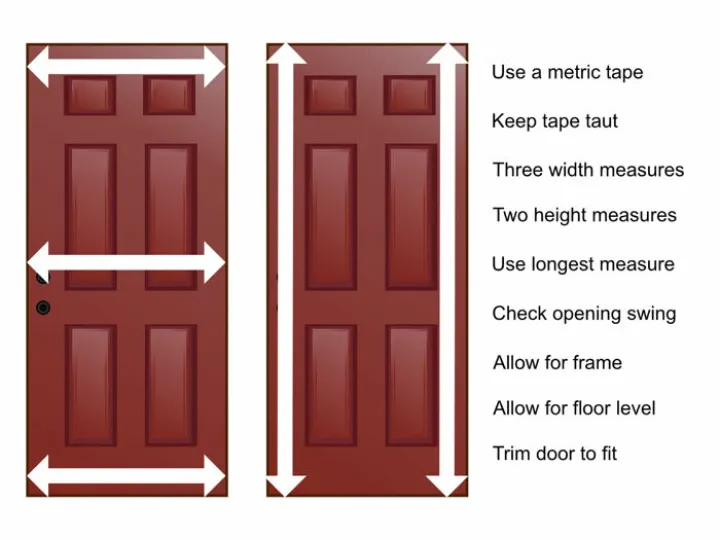Measuring for a new door
Measuring for a new or replacement door is relatively straightforward, but there are a few key considerations to ensure the replacement door is an exact fit and functions properly.
If in doubt about the exact measurement, a good rule of thumb is to always err on the larger size because a door can always be cut down to fit, but cannot easily be made bigger.
A replacement door that is too small for the opening will let in draughts and be less secure than one that fits well, so it's worth taking time to ensure a good fit.
Although you can measure for a new door yourself, we highly recommend using a professional installer with experience measuring interior and exterior doors.
A reputable installer will ensure, and most likely guarantee, a perfect fit for your new doors without any rattles, draughts or security issues.
To do the job yourself, you will need to measure the height, width, and depth of the door opening, taking special note of the direction of the door swing.
Measure the door width
Start by measuring the width of the inside of the door frame from one door jamb to the other. To ensure a good door fit, take measurements at the top, middle, and bottom of the door opening, and note down the widest measurement in millimetres.
Keep the measure taut to ensure it is in a straight line perpendicular to the door jambs. If the original door fits nicely inside the frame, you can use this as a guide to make your measurements; however, using the door frame will always be more accurate.
Measure the door height
Next, measure the height inside the door frame. Again, keep the tape taut and measure from the floor to inside the door frame. Take two measurements on the left and right corners of the frame and choose the longest of the two measurements in millimetres.
Remember, you can always plane and sand a door down to fit an opening, but you can't make a door bigger to accommodate a gap. If the floor or lintel is not perfectly horizontal or level, the door can be 'shaped' down to the gap. You may need to take some small steps or use a chair to make these measurements. The standard height of doors in the UK is 6'6" or 1981mm, but some may be longer than this.
Measure the door frame
Third, measure the depth of the door frame. This is where the door will fit when it's closed. There may be a rebate in the frame where the door sits. Most internal doors come in one of three standard thicknesses: 35mm, 40mm or 44mm, so the depth should be one of these measurements.
If the door opening does not have a frame, you must measure the whole door set. To do this, you will need to measure the width from brick to brick, from top to bottom and take the shortest measurement.
Repeat this at 10 cm intervals from the floor to the lintel to get the shortest height. Once you have both measurements, factor in the width of the door frame to determine the required width. As mentioned, it's always better to go too big than too small, as a door can be easily cut down to size.
Other measures to consider
Measuring for internal doors is something anyone can undertake; however, there are additional factors to consider. Always check which way the door will swing before finalising the measurements.
Another aspect to remember when recording door measurements is how the door opens. Stand so the door opens away from you and check which side the hinges are placed on. Left-side hinges mean the door opens to the left, and right-side hinges are right-hand, opening away.
If the floor is not level or a floor covering has not yet been laid, the newly fitted door may not be able to open. Ensure that you factor in any floor alterations before finalising the measurements for your new door. Most internal doors can be trimmed between 4mm and 30mm, depending on the material and the design.
Standard door sizes
The standard door size in the UK varies by region and door type. In England and Wales, the most common door size is 1981 mm (6 ft 6 in) high and 762 mm (2 ft 6 in) wide, while in Scotland, it's 2040 mm (80 in) by 762 mm (2 ft 6 in). Most internal doors across the UK are 35mm deep, but you will find many in Scotland that are 40mm thick.
Fire doors come in two widths, depending on the required fire rating. FD30 (30-minute) fire doors are 44mm thick, while FD60 (60-minute) are 54mm. For private homes, fire doors are recommended for higher-risk rooms such as kitchens and integral garages. In three-storey homes and those with loft conversions, any rooms that could be escape routes should have a fire-rated door and frame.
Even in new homes, where door openings are standard, it's common for doors to require trimming to fit perfectly in the frame and to clear the opening. Lippings are the solid border edges of a door that can be cut to get the right fit. They vary in size, typically ranging from 8mm to 20mm, which is sufficient for most door installations.
It's more than likely that a standard-sized door can be sufficiently trimmed during installation to fit. If you think your new door will require more trimming than this, you should consult with the supplier and choose a door style that has a generous lip.
More on replacing doors
Security for doors
Benefits of composite
Choose a FENSA intaller
CALL 01606 863553
for a free quote on replacement doors
Select Window Systems
Phone: 01606 863553
Email: hello@swsonline.co.uk
Visit: Unit 2, Woodford Court, Winsford, Cheshire, CW7 2RB
Cheshire doors and windows.
Window and door installations across Cheshire.
Visit Our Cheshire Showroom
Disclaimer
Select Window Systems accepts no responsibility or liability for any damages or costs of any type arising out of or in any way connected with your use of this website. Select Window Systems cannot be held liable for any actions taken in reliance on any published content, which is for information purposes only.


